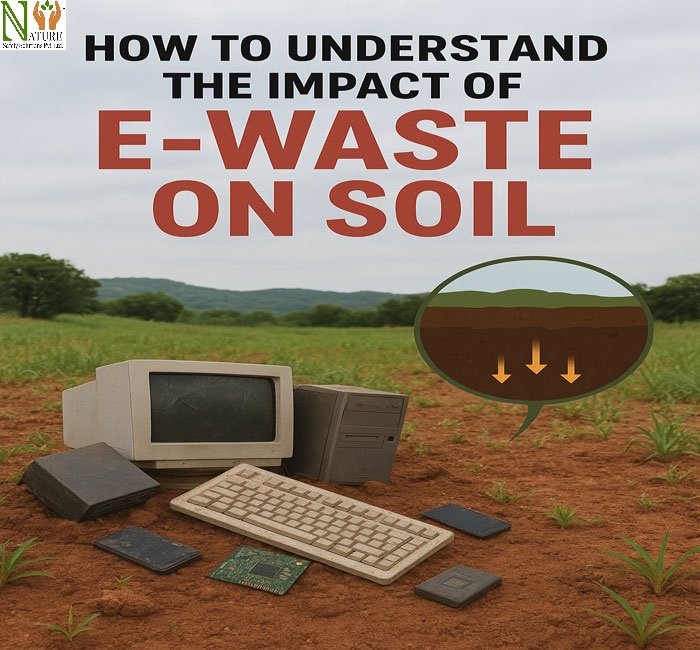Electronic devices have become an essential part of our daily lives. From smartphones and laptops to televisions and household appliances, technology makes life easier. But as technology grows, so does the problem of electronic waste, also known as e-waste.
Unlike other types of waste, e-waste contains harmful metals and chemicals that can remain in the environment for decades. One of the most serious problems caused by e-waste is soil contamination. This hidden danger affects plants, food, water, and human health. Understanding how e-waste pollutes soil is the first step toward finding solutions.

What Is E-Waste?
E-waste refers to discarded electronic items such as phones, computers, televisions, refrigerators, and batteries. These devices are made of different materials, including plastics, metals, and glass. While some of these materials can be recycled, many also contain toxic elements such as lead, cadmium, and mercury.
If these devices are not disposed of safely, the harmful substances inside them escape into the environment. Unlike organic waste, which breaks down naturally, the toxins in e-waste remain in the soil for a very long time, making it dangerous to both nature and people.
How E-Waste Pollutes Soil
Soil becomes contaminated when harmful chemicals from e-waste leak into the ground. This can happen in several ways. In landfills, rainwater washes chemicals out of discarded electronics and carries them deeper into the soil.
In many places, e-waste is burned to recover metals like copper and gold, and the ash that settles on the ground leaves behind toxic residues. Informal recycling sites, where workers dismantle electronics without protective equipment, also release dangerous materials directly into the soil. These practices slowly poison the land, turning fertile ground into polluted waste.
Impact on Soil Quality
Healthy soil is essential for growing crops and supporting ecosystems. When it is contaminated by e-waste, the soil loses its natural balance. Toxic metals reduce fertility, making it difficult for plants to grow. Microorganisms that normally recycle nutrients and keep the soil alive are killed by the pollution.
What makes the problem worse is that many of the toxic substances do not break down over time. Lead, cadmium, and mercury can remain in the soil for decades, meaning the damage is long-lasting and very difficult to reverse.
Risks to Plants and Food
Plants growing in polluted soil often absorb harmful chemicals through their roots. These toxins move into fruits, vegetables, and grains, eventually reaching the food we eat. This process is slow and invisible, but over time it can make food unsafe.
Animals that feed on contaminated plants are also affected, which means the pollution spreads through the entire food chain. Even if the soil looks normal, the crops grown in it may carry dangerous substances that harm health when consumed regularly.
Effects on Human Health
Soil contamination from e-waste is not just an environmental issue – it is also a serious health risk. People who live near e-waste dumps or recycling sites are the most vulnerable. They may eat food grown in polluted soil, breathe in dust mixed with toxic particles, or come into direct contact with contaminated land.
The health problems caused by exposure to these toxins include kidney damage, respiratory issues, nervous system disorders, and even cancer. Children are especially at risk because their bodies are more sensitive to harmful chemicals, and the effects can last throughout their lives.
Environmental Consequences
The danger does not stop with the soil. Once the ground is polluted, harmful substances can move deeper and mix with underground water sources. From there, they spread into rivers and lakes, damaging aquatic life and making water unsafe to drink.
Animals that depend on the soil and plants for food are also affected, creating a chain reaction that harms the entire ecosystem. Soil pollution caused by e-waste is therefore not just a local problem but one that has wide-reaching consequences for the planet.
Reducing the Impact
Although the problem is serious, solutions are possible. Recycling electronics through certified facilities prevents harmful chemicals from reaching the soil. Repairing or reusing old devices can reduce the amount of waste created in the first place. Proper disposal systems, where e-waste is collected separately from household garbage, also make a big difference.
At the same time, awareness is crucial. Many people are not aware of the dangers of e-waste, so educating communities can encourage safer habits. Governments and companies also need to take responsibility by creating stronger laws and recycling programs.
Also read:-
